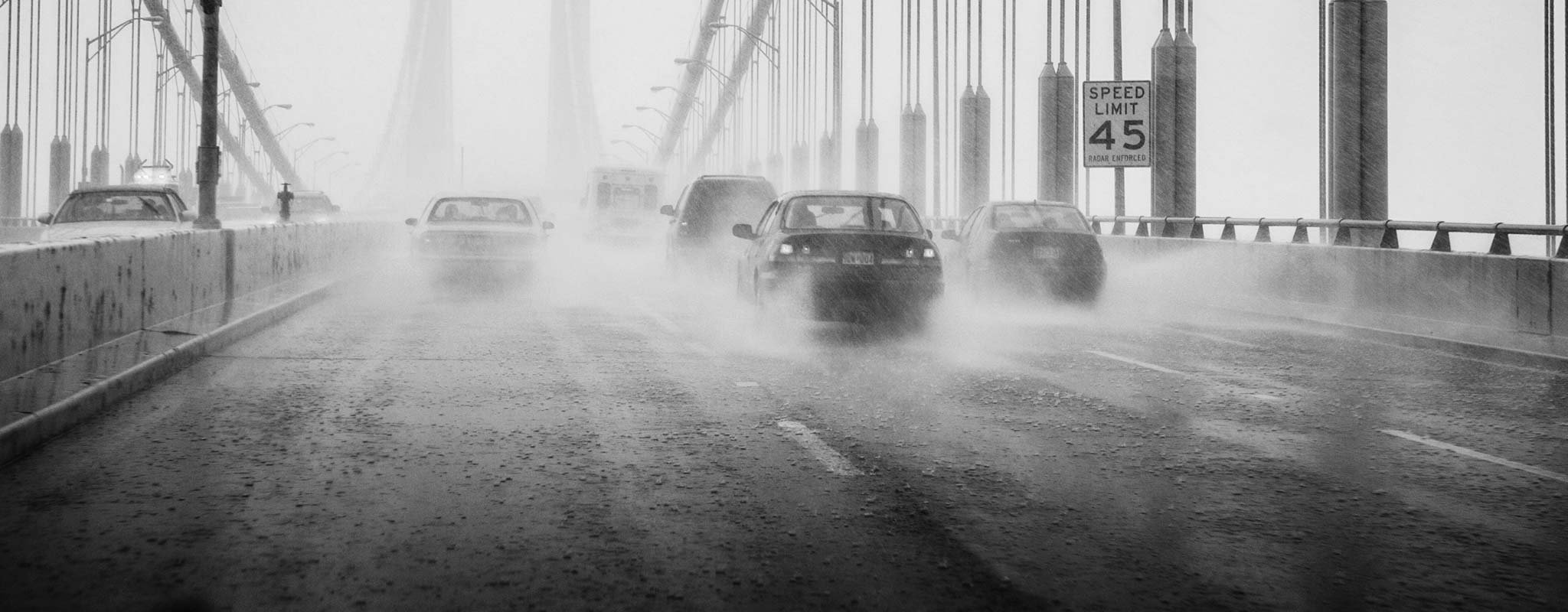10 Safety Tips for Driving in the Rain
When it rains, and especially in the first 10 minutes of a storm, roads can become slick due to engine oil and grease buildup that has yet to wash away. That’s when you’re most likely to experience hydroplaning. Losing control of your vehicle at high speeds isn’t fun, but we have some tips to help you avoid the ice-like effects of hydroplaning and how to drive safely in the rain.
What You’ll Find in This Article
The pros at Les Schwab have pulled together tips based on years of driving and safety experience.
What Is Hydroplaning?
Hydroplaning happens when your tires lose contact with the road and start rolling on top of a thin film of water. It can happen any time a tire’s tread can't channel water away fast enough to maintain proper contact with the road. When tire tread is in good condition, the grooves and sipes help move water away from the tire to keep you in control and possibly avoid hydroplaning.
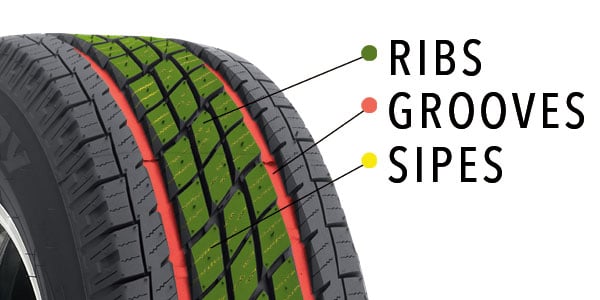
As tires wear over time, the tread depth decreases and the grooves aren’t as deep. Learn how to check your tire tread. When the tread is diminished enough, less water gets moved by the grooves. This can lead to hydroplaning. It can also happen if you’re driving too fast for the conditions, even if your tires are in good shape.
What It Feels Like
When your vehicle begins to hydroplane, you’ll feel as if your car or truck is floating or veering on its own. This could result in a loss of steering and braking. How much control you have depends on how fast you’re going and which tires are being affected. If your drive-wheels hydroplane, there might be an increase in your speedometer and engine RPMs (revolutions per minute) as your tires begin to spin. This can cause you to lose control. When your non-drive wheels hydroplane, your car could begin to veer sideways into a spin or skid. If all four wheels hydroplane, the car could skid forward in a straight line.
What to Do If You Hydroplane
Unlike sliding on snow and ice, the best way to stop hydroplaning is to take your foot off the gas. Do not brake or attempt to steer into or out of a skid or spin. Most of the time, hydroplaning lasts for only a second or two.
If you do hit the brakes out of pure instinct, ease up on the brakes until it’s over. If you drive a manual transmission, you’ll also want to keep the clutch pedal pressed to the floor. Additionally, don’t slam on the brakes or yank the steering wheel. This could cause you to lose further control. It’s best to wait to brake until you're out of the skid.
However, if you must brake to avoid an accident, brake normally. If your vehicle doesn’t have ABS, pump the brakes lightly. To avoid other vehicles or obstacles, you may need to steer. Just be sure to do as little steering as you can until you’ve regained control. It’s very easy to oversteer when hydroplaning.
Prepare for Rainy Days
Before you end up driving on freshly rained-on roads or during a downpour, check your windshield wiper blades and replace them if necessary, and double-check that your headlights are in good working order. Additionally, have your tires, air pressure, and brakes checked at Les Schwab. We’ll let you know if you need new tires, properly inflate the ones you have to help keep you in control, and check your brakes.
How to Avoid Hazards While Driving in the Rain
According to the Federal Highway Administration, 75% of weather-related auto crashes occur on wet pavement and during rainfall. Additionally, heavy rain reduces visibility. Every year, over half-a-million people are injured in crashes on wet pavement, and nearly as many are hurt in crashes during a rainstorm.
Maintaining your tires and driving with extra care when it rains, and in foggy conditions, can help you get to where you’re going without an incident. We’ve put together some tips to help keep you and your family safe.
Top 10 Tips for Safely Driving in the Rain
-
Wait for the storm to pass
This can be especially important if your tires need to be replaced or if the tread is low. When tires are worn, the grooves in those tires cannot move water away fast enough to avoid hydroplaning. Even if your tires have plenty of traction left, waiting out the storm helps you avoid driving alongside other drivers with less-than-adequate tires.
-
Avoid bald tires
Bald tires or tires with little-to-no tread or traction can be especially dangerous on wet roads. A set of all-season tires from Les Schwab can help you maintain contact with the road and control of your vehicle, whether you’re driving on bare pavement, in the rain, or light snow.
-
Turn on your headlights
This helps you see better and allows other drivers to see you. However, remember to keep your headlights on low to avoid glare in rainstorms, which can cause additional visibility issues.
-
Slow down
You’re less likely to hydroplane at or below 35 MPH (miles per hour). If you must travel far below the speed of traffic, stay in the right lane and turn on your hazards. This will help alert other drivers to the danger.
-
Leave room between vehicles
Similar to driving on snow and ice, it’s important to leave enough space between you and the car ahead of you during a rainstorm. With reduced visibility and braking distance, giving yourself an extra split second to avoid problems could keep you from becoming a statistic.
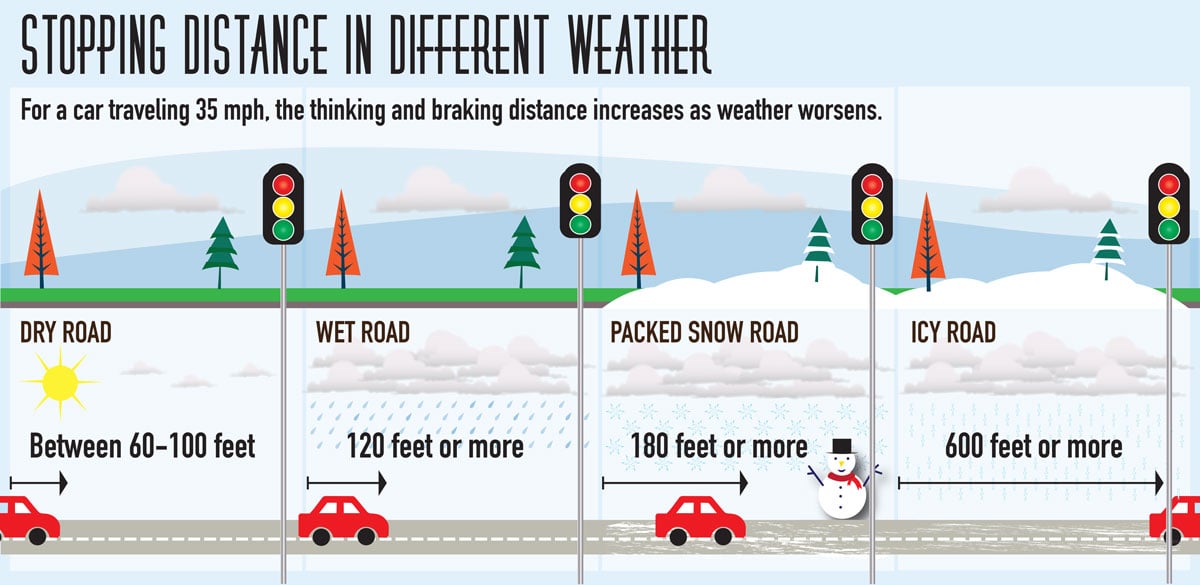
-
Don’t use cruise control
Using cruise control in a rain storm can cause your tires to spin faster if you start to hydroplane. Then, your vehicle could fishtail and lose steering control when the tires regain traction.
-
Don’t drive through water flowing across the road
That water might not look deep, but even as little as 12-inches of moving water can sweep your vehicle off the road or into oncoming traffic. Instead, find an alternative route or wait for the storm to pass, if possible.
-
Drive carefully
Anytime you’re faced with wet roads or downpours, avoid hard braking, sudden acceleration or sharp turns. This can help minimize the possibility and effects of hydroplaning.
-
Stay in your lane
Lane changes and passing in rainy conditions can increase your chances of hydroplaning. Why? Because as you move out of the tracks created by the vehicle in front of you, your tires will need to move more water to maintain contact with the road. Also, rain can cause poor visibility and increased stopping distances.
-
Avoid puddles and standing water
It’s almost impossible to know how deep a puddle or other standing water really is. Even the best tires cannot move water away fast enough to keep you from hydroplaning at high speeds through deep water. Additionally, going through standing water can stall your engine and leave you stranded if enough water gets into the intake or exhaust. If you do make it safely through a large puddle, check that your brakes are working properly by tapping them gently a few times.
Les Schwab Takes Safety Seriously
The right set of tires for your vehicle can help minimize hydroplaning and keep you in control. Stop by your local Les Schwab for more driving advice and free safety checks. We’ll do whatever it takes to help you get the most out of your tires and keep you rolling safely down the road.
Find A StoreImportant Notice: The information provided above is of a general nature gathered from a variety of resources deemed reasonably reliable. The operation of your vehicle, or the repair or replacement of your vehicle’s equipment, may be different than for a typical vehicle. Please consult your owner’s manual for specific warnings, notices, and other advice relative to the subjects addressed herein.
What you need to know

Winter Driving Tips: How to Drive in Snow
When you’re driving on snow or you’re caught in a storm, remember the following winter driving tips for safer vehicle handling.
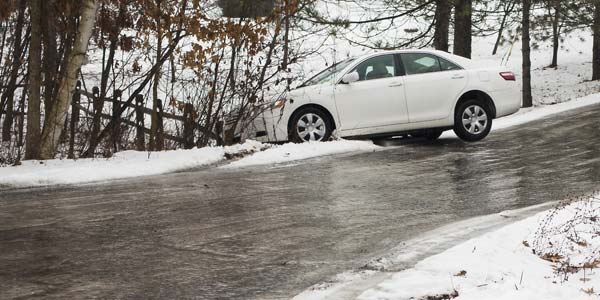
How to Drive Safely on Ice: Top Tips for Keeping Your Car on the Road
It’s best not to drive at all when roads are icy. But here’s what to know to get where you’re going safely if roads turn icy.
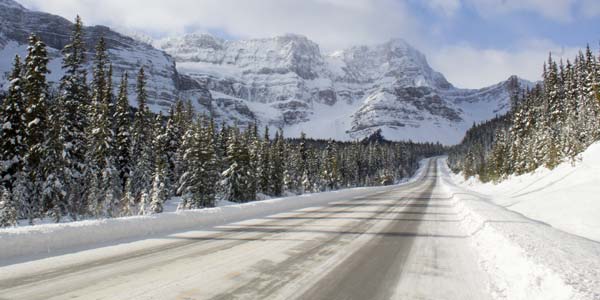
How to Drive Safely on Mountain Roads
How to drive in the mountains and stay in control when encountering ice and other weather conditions that can impact your safety.

